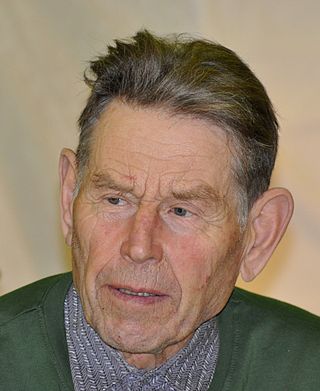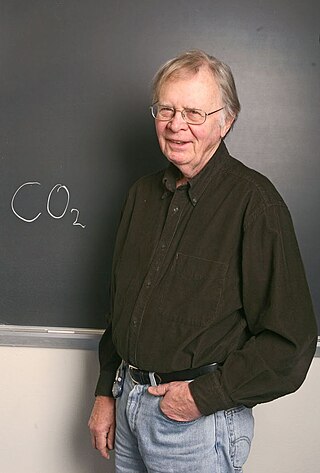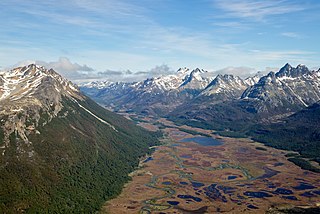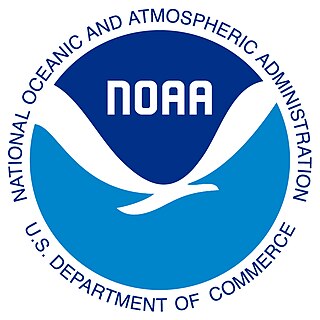Related Research Articles

The National Academy of Sciences (NAS) is a United States nonprofit, non-governmental organization. NAS is part of the National Academies of Sciences, Engineering, and Medicine, along with the National Academy of Engineering (NAE) and the National Academy of Medicine (NAM).

Peat is an accumulation of partially decayed vegetation or organic matter. It is unique to natural areas called peatlands, bogs, mires, moors, or muskegs. Sphagnum moss, also called peat moss, is one of the most common components in peat, although many other plants can contribute. The biological features of sphagnum mosses act to create a habitat aiding peat formation, a phenomenon termed 'habitat manipulation'. Soils consisting primarily of peat are known as histosols. Peat forms in wetland conditions, where flooding or stagnant water obstructs the flow of oxygen from the atmosphere, slowing the rate of decomposition. Peat properties such as organic matter content and saturated hydraulic conductivity can exhibit high spatial heterogeneity.

The Goldman Environmental Prize is a prize awarded annually to grassroots environmental activists, one from each of the world's six geographic regions: Africa, Asia, Europe, Islands and Island Nations, North America, and South and Central America. The award is given by the Goldman Environmental Foundation headquartered in San Francisco, California. It is also called the Green Nobel.

Kontiolahti is a municipality of Finland. It is located in the North Karelia region, about 20 kilometres (12 mi) north of Joensuu. The municipality has a population of 15,121 and covers an area of 1,029.82 square kilometres (397.62 sq mi) of which 230.1 km2 (88.8 sq mi) is water. The population density is 18.91 inhabitants per square kilometre (49.0/sq mi). Neighbouring municipalities are Joensuu, Juuka, Lieksa, Liperi and Polvijärvi. The municipality is unilingually Finnish.

Sir John Theodore Houghton was a Welsh atmospheric physicist who was the co-chair of the Intergovernmental Panel on Climate Change's (IPCC) scientific assessment working group which shared the Nobel Peace Prize in 2007 with Al Gore. He was the lead editor of first three IPCC reports. He was professor in atmospheric physics at the University of Oxford, former Director General at the Met Office and founder of the Hadley Centre.

Kaarlo Pentti Linkola was a prominent Finnish deep ecologist, ornithologist, polemicist, naturalist, writer, and fisherman. He wrote widely about his ideas and in Finland was a prominent thinker, and is linked by some authors to ecofascism and to authoritarian deep ecology. Linkola was a year-round fisherman from 1959 to 1995. He fished on Keitele, Päijänne and the Gulf of Finland, and since 1978 he fished on Vanajavesi.

Wallace "Wally" Smith Broecker was an American geochemist. He was the Newberry Professor in the Department of Earth and Environmental Sciences at Columbia University, a scientist at Columbia's Lamont–Doherty Earth Observatory and a sustainability fellow at Arizona State University. He developed the idea of a global "conveyor belt" linking the circulation of the global ocean and made major contributions to the science of the carbon cycle and the use of chemical tracers and isotope dating in oceanography. Broecker popularized the term "global warming". He received the Crafoord Prize and the Vetlesen Prize.

The Cooperative Institute for Research in Environmental Sciences (CIRES) is one of the largest research institutes at the University of Colorado Boulder (CU) and hosts NOAA's largest cooperative institute, CIESRDS. CIRES scientists study the Earth system, including the atmosphere, hydrosphere, cryosphere, biosphere, and geosphere, and communicate these findings to decision makers, the scientific community, and the public.

Carbon sequestration is the process of storing carbon in a carbon pool. Carbon sequestration is a naturally occurring process but it can also be enhanced or achieved with technology, for example within carbon capture and storage projects. There are two main types of carbon sequestration: geologic and biologic.

David John Karoly is an Australian atmospheric scientist, currently based at CSIRO.

Finland is one of the last countries in the world still burning peat. Peat has high global warming emissions and environmental concerns. It can be compared to brown coal (lignite) or even worse than this lowest rank of coal. Peat is considered the most harmful energy source for global warming in Finland. According to IEA the Finnish subsidies for peat in 2007-2010 undermined the goal to reduce CO
2 emissions and counteracted other environmental policies and The European Union emissions trading scheme.

In earth science, global surface temperature is calculated by averaging the temperatures over sea and land.

A peatland is a type of wetland whose soils consist of organic matter from decaying plants, forming layers of peat. Peatlands arise because of incomplete decomposition of organic matter, usually litter from vegetation, due to water-logging and subsequent anoxia. Like coral reefs, peatlands are unusual landforms that derive mostly from biological rather than physical processes, and can take on characteristic shapes and surface patterning.

The National Centers for Environmental Information (NCEI) is a U.S. government agency that manages one of the world’s largest archives of atmospheric, coastal, geophysical, and oceanic data. The current director is Derek Arndt.
Paludiculture is wet agriculture and forestry on peatlands. Paludiculture combines the reduction of greenhouse gas emissions from drained peatlands through rewetting with continued land use and biomass production under wet conditions. “Paludi” comes from the Latin “palus” meaning “swamp, morass” and "paludiculture" as a concept was developed at Greifswald University. Paludiculture is a sustainable alternative to drainage-based agriculture, intended to maintain carbon storage in peatlands. This differentiates paludiculture from agriculture like rice paddies, which involve draining, and therefore degrading wetlands.

Due to its geographical and natural diversity, Indonesia is one of the countries most susceptible to the impacts of climate change. This is supported by the fact that Jakarta has been listed as the world's most vulnerable city, regarding climate change. It is also a major contributor as of the countries that has contributed most to greenhouse gas emissions due to its high rate of deforestation and reliance on coal power.

Selkie is a village of Kontiolahti in North Karelia, Finland. It has a population of about 300.
Kimiko Hirata is a Japanese climate activist. As a founder of the Kiko Network, a non-governmental organization, she has campaigned for emissions reductions for more than 20 years. As of December 2022, her grassroots work has led to the cancellation of 17 planned coal-power plants. Hirata also led landmark coal divestment campaigns against Mizuho Financial Group and Mitsubishi UFJ. She currently serves as executive director for the Tokyo-based think tank, Climate Integrate, which focuses on accelerating decarbonization.

Peatland restoration is a term describing measures to restore the original form and function of peatlands, or wet peat-rich areas. This landscape globally occupies 400 million hectares or 3% of land surface on Earth. Historically, peatlands have been drained for several main reasons; peat extraction, creation of agricultural land, and forestry usage. However, this activity has caused degradation affecting this landscape's structure through damage to habitats, hydrology, nutrients cycle, carbon balance and more.
References
- ↑ "Finland Drained Its Peatlands. He's Helping Bring Them Back". YaleEnvironment360. 2 May 2023. Retrieved 10 August 2023.
- ↑ Palmer, Jane (25 July 2022). "Tero Mustonen: Disrupting the Status Quo". Eos. Retrieved 10 August 2023.
- ↑ Nandini Mitra, Maureen (24 April 2023). "For Tero Mustonen, Restoring Finland's Peatlands is About Saving Our Planet's 'Second Lung'". Earth Island Journal. Retrieved 10 August 2023.
- ↑ Schueman, Lindsey Jean (25 April 2023). "Climate Hero: Tero Mustonen". One Earth. Retrieved 3 August 2023.
- ↑ "Tero Mustonen". ICCA Consortium. Retrieved 10 August 2023.
- ↑ "Tero Mustonen". Goldman Environmental Prize . Retrieved 3 August 2023.
- ↑ Rascoe, Ayesha (7 May 2023). "Meet the scientist restoring Finland's peatlands". NPR . Retrieved 10 August 2023.
- ↑ "Climate researcher and professional fisherman Tero Mustonen selected as UEF's Alumnus of the Year". University of Eastern Finland. 2023-11-28. Retrieved 2024-01-22.